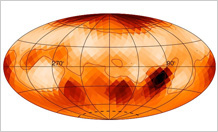
Image credit: Roettenbacher, Monnier, et al.
Ground-breaking images of nearby star give new insight into Sun’s infancy
Pioneering new research that has provided close-up pictures of a nearby star has given a fascinating insight into how the Sun may have behaved billions of years ago.
A team of international astronomers, including Professor Stefan Kraus from the University of Exeter, have used cutting–edge techniques to create the first direct image of surface structures on the star Zeta Andromedae – found 181 light years from Earth.
In order to image the star’s surface during one of its 18-day rotations, the researchers used a method called interferometry, where the light of physically separate telescopes is combined in order to create the resolving power of a 330m telescope.
They discovered the star, which is found in the northern constellation of Andromeda, showed signs of ‘starspots’ – the equivalent of sunspots found within our own solar system. The pattern of these spots differs significantly from those found on the Sun.
The researchers suggest these results challenge current understandings of how magnetic fields of stars influence their evolution. Furthermore, they believe that the findings offer a rare glimpse of how the Sun behaved in its infancy, while the solar system was first forming.
The findings are published in leading scientific journal Nature on 4 May.
Professor Kraus, an Associate Professor in Astrophysics at the University of Exeter said: “Most stars behave like giant rotating magnets and starspots are the visible manifestation of this magnetic activity. Imaging these structures can help us to decipher the workings that take place deep below the stellar surface.”
Sunspots and starspots are cooler, darker areas of a star’s outer shell that form when stronger regions of the magnetic field block the flow of heat and energy in patches. However, while on the Sun spots only form in bands just above and below its equator, the team found something quite different on Zeta Andromedae.
As well as one starspot in the star’s northern polar region, there were also several additional spots that spread across lower latitudes. The images show, for the first time, that stars with strong magnetic fields could have spots near their pole.
“While imaging sunspots was one of the first things that Galileo did when he started using the newly invented telescope, it has taken more than 400 years for us to make a powerful enough telescope that can image spots on stars beyond the Sun,” said John Monnier, professor of astronomy in the University of Michigan’s College of Literature, Science and the Arts.
“It’s important to understand the Sun’s history because that dictates the Earth’s history – its formation and the development of life,” said Rachael Roettenbacher, a postdoctoral researcher in astronomy who conducted this research as part of her doctoral thesis at the University of Michigan. “The better we can constrain the conditions of the solar environment when life formed, the better we can understand the requirements necessary for the formation of life.”
“Our images unambiguously show polar starspots on Zeta Andromedae for the first time. Now we can see that the spots aren’t restricted to forming only in symmetric bands around the equator as sunspots are. We see the starspots in both hemispheres and at all different latitudes. This can’t be explained by extrapolating theories about the Sun’s magnetic field.”
And the additional, lower latitude spots are spread over such an extended cool region that the scientists say they’ve found evidence that magnetic fields can suppress heat flow across a large part of the star’s surface, rather than just in spots. Astronomers use star temperatures to estimate their ages, so they need to know if anything, such as these extended cool regions, is throwing off those temperature measurements.
Date: 4 May 2016
